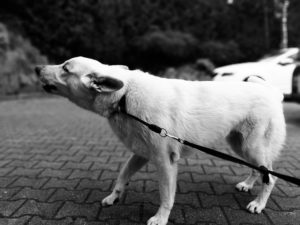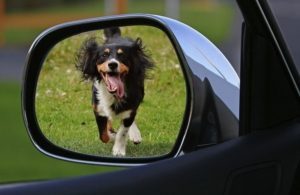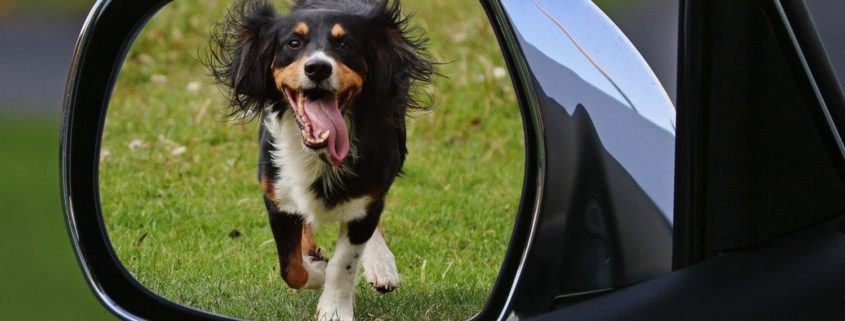Ask Crystal: Advice on Chasing Cars
Welcome to “Ask Crystal,” where you can ask your pet behavior questions! You can submit your question for Crystal at the bottom of the page!
Dear Crystal,
I have a problem with my dog who is barking and lunging at cars while we are out for walks. This started the week of Christmas, before my family arrived.
I am trying to put her in a sit when I see a car approaching and give her a treat. We walk on the sidewalks in the apartment complex. Cars are going by slowly. There is not much traffic. She is 60 pounds and it is all I can do to hold on to her. Can you provide any suggestions?
Sincerely,
Holding On for Dear Life
Dear Holding,
 I can definitely sympathize with this issue. My dog began this same behavior a few months after we got him when a car drove by too close one time. I have been working on his training for this problem for the past 6 months. Things are slowly improving but he still barks and spins if a car drives by too closely. The difficulty in working on this issue for you especially will be the fact that you live in an apartment where there are going to be cars driving around more closely and more frequently than if you lived in a house. When dogs are afraid of things and they are constantly exposed to their triggers, it makes it more difficult to work on the training aspect of the problem.
I can definitely sympathize with this issue. My dog began this same behavior a few months after we got him when a car drove by too close one time. I have been working on his training for this problem for the past 6 months. Things are slowly improving but he still barks and spins if a car drives by too closely. The difficulty in working on this issue for you especially will be the fact that you live in an apartment where there are going to be cars driving around more closely and more frequently than if you lived in a house. When dogs are afraid of things and they are constantly exposed to their triggers, it makes it more difficult to work on the training aspect of the problem.
First, we need to think about how to best manage her so that she is exposed as little as possible. Avoiding walking by roads is a given. It is lucky that you have sidewalks and your complex is on the quiet side. I would suggest paying attention to the times of day when there is the most traffic and avoid taking her out at those times if possible. You may have more luck early before people leave for work, during the middle of the day and later in the night after people get home. Also, look for potty spots that are out of the way and away from the cars. On the equipment side, you may want to try a head halter such as the Halti or Gentle Leader. Many trainers find that the head halters work well for reactive dogs because it helps turns their head back to you so you can redirect the dog’s attention. You could try a different harness like the Freedom Harness which has two points of contact for better control over the dog.
Asking her to sit and look at you may be a way to manage the situation when a car drives by too closely. It won’t change how she feels about the cars, but you do need ways to distract her when cars drive by until you can change how she feels about them. I really like to teach a find it cue for a variety of issues. I found it helped tremendously with my dog’s dog reactivity. Always start teaching any new cue inside the house where there are less distractions.
One way is through teaching “Find It.” Drop a treat on the ground and say, “find it”, as the dog is eating the treat, drop another treat when she can’t see you drop it and say, “find it”. If she has trouble finding it, you can use your foot to point out where it is. The point of her not seeing you drop is that she will keep her nose to the ground and search rather than looking up to see what your hand is doing. Practice this in the house a lot. If your dog really likes her kibble, you can use her meals to train this daily. It needs to be an automatic response so when you say, “find it” the dog drops her nose to the ground to look for treats. Once she knows the cue really well inside, start practicing outside when there aren’t cars around. Then you can start using it when you see that a car is moving around to distract her from noticing those cars. In this case, you need to use really amazing treats to compete with the distraction so bring out the big guns.
You may also want to play some attention games with her so that she will be more likely to turn and face you when you need to get her attention. I like to play attention games because if we use games to train our dogs, they are not only reinforced by the food but also by the activity. Practice inside the house, standing in front of the dog. Wait for her to look at you, say “yes” when she does and drop a treat on the ground in front of you. You can also drop a treat to the right and then one to the left, so the dog is ping ponging back and forth. Start working outside by calling your dog over to you and playing either of these games. This can be a great way to hold her attention while a car passes by.

“Photo by Steve Freling of Motor Oomph“
In order to change the feelings that cause her to lunge and bark, we need to use a program of desensitization and counter conditioning. The idea is to expose her to the trigger which is causing the fear at a level which she can tolerate and pair it with something positive to create a positive association. First, you need to be able to identify your dog’s stress signals. We know she barks and lunges but there are likely some more subtle signals of distress that she also shows. Many dogs will shake, pant, whine and drool as well. You need to be able to recognize any signs of distress and then move back a distance at which your dog is not showing these signals. We call this the threshold. In order to change a dog’s behavior, we must work under the dog’s threshold. Once you cross the threshold and the dog is barking you have gone too far and the dog is unable to learn. We want to avoid flooding the dog. Forcing a dog to face its fears does not work and will often cause the dog to become worse.
A good way to start training that will likely be under threshold is inside the apartment. Open the windows when cars are driving around. When you see her notice the sound of cars, say “yes” and feed an amazing treat. This may look like her ears perking up and turning towards the sound. You may also want to open the window when feeding so she associates the sounds with food. The next step would be having her on a leash and open the front door. Stand in the doorway with her and say “yes” and treat anytime she notices a car. This could be looking at a car or her ears perking up at the sounds. Next you can stand just outside the door and mark and reward the noticing of cars. Start working closer and closer to the sidewalk and the cars gradually. It can require some finesse to notice when you have gone too far and take a step back. The process can be slow. You are looking for the dog to be comfortable before moving on to the next step. If they seem stressed, then you are moving too fast. You will also notice that she will start to look at you after noticing the cars as if to say, “Where’s my treat?”. When she gets to that stage, say “yes” when she looks at the car but wait until she looks at you to feed the treat. In this way we are also reinforcing checking in with us. You may want to have a friend help you with training by asking them to slowly drive by so you can have a training session rather than standing outside waiting for a car. Once she gets better in your parking lot, the next step would be taking her to new places to practice. I would try to start with quiet locations and build up to locations with more traffic. Dogs don’t generalize some behaviors very well, so it helps to practice in different locations.
It can be difficult and time consuming to change how a dog feels about something. The easiest answer is always management but for an issue like this you can’t only manage it. Your dog is going to have to see cars at various points in her life. At this point, you must avoid areas with a lot of traffic and start your training. In my case, this has been the main issue I have been working on because other issues can stem from this problem, so it is an important issue to resolve. Good luck and happy training!
Until next time,
Crystal
Want more training for your animal? Sign up now for the first session of 2020 Manners 101 classes here!







